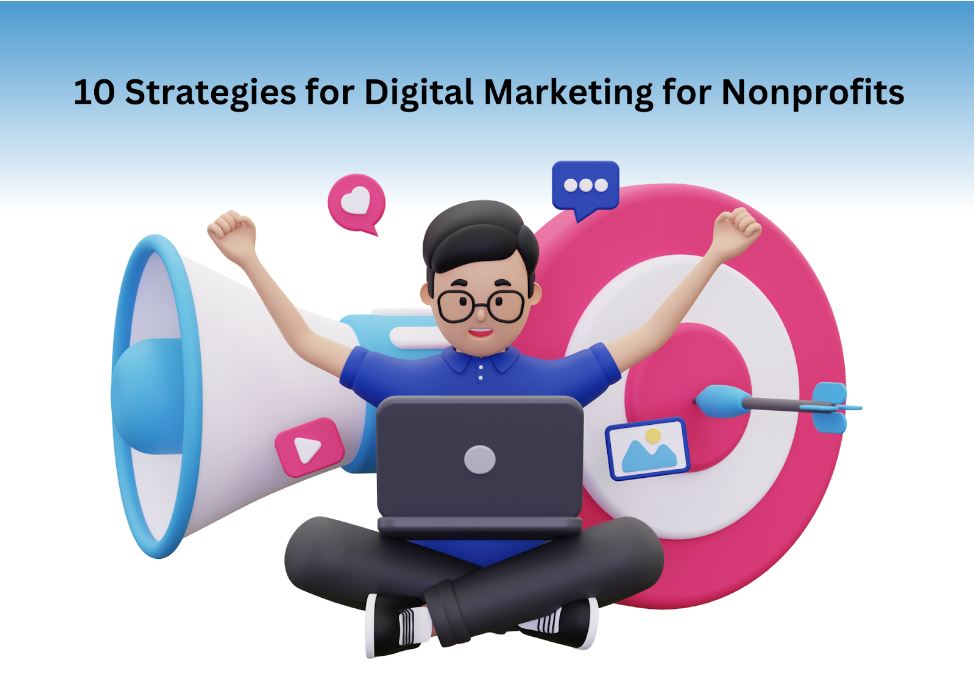Image Source: Canva
In today’s digital age, nonprofits must harness the power of online platforms to amplify their message and reach their goals. With the right strategies, digital marketing can be a game-changer for organizations looking to make a difference. Let’s explore 10 effective strategies that can help your non-profit thrive in the digital space.
1. Email Marketing
Email marketing remains one of the most effective digital marketing tools for nonprofits. It allows you to communicate directly with supporters and cultivate long-term relationships.
Personalization is key to successful email marketing. Use your audience segments in your messages. For example, you might send different content to new subscribers versus long-term donors.
Consistency is also crucial. nonprofits that send at least less than one email per month raise 57% more than those that don’t. However, quality is more important than quantity. Each email should provide value to the recipient.
Consider creating a welcome series for new subscribers. This can help introduce them to your organization and encourage early engagement.
Don’t forget to optimize your emails for mobile devices. Many people check their emails on smartphones, so your messages need to look good on smaller screens.
2. Know Your Audience
Knowing your audience is crucial for crafting messages that resonate. Start by analyzing your current supporter base. Look at demographics, donation history, and engagement levels. This data will help you create detailed personas of your typical supporters.
Once you have a clear picture of your audience, segment them into groups based on shared characteristics. You might have segments for first-time donors, long-term supporters, volunteers, and corporate partners.
Tailoring your communication to each segment can significantly boost engagement. nonprofits that segment their email marketing lists see a 31% open rate and a 34% click-through rate.
Don’t forget to regularly update your audience profiles. People’s interests and circumstances change over time, and your segmentation should reflect these changes.
3. Social Media
Social media platforms offer nonprofits a powerful way to engage with supporters and raise awareness. With 92% of nonprofits using social media, it’s clear that these platforms are essential for outreach.
Each social media platform has its own strengths and audience demographics. Facebook is great for building community and sharing longer-form content. Instagram excels at visual storytelling. Twitter is ideal for real-time updates and conversations.
Share a mix of content types to keep your audience engaged. This might include impact stories, behind-the-scenes glimpses, volunteer spotlights, and calls to action. Remember to engage with your followers. Respond to comments, ask questions, and create polls to encourage interaction. This two-way communication helps build stronger relationships with your supporters.
Consider using social media management tools to schedule posts and track engagement. This can help you maintain a consistent presence without overwhelming your team.
4. Establish Clear Marketing Goals
Setting clear marketing goals is the foundation of any successful digital strategy. Start by defining SMART goals that align with your non-profit’s mission and overall goals.
For instance, you might aim to increase monthly online donations by 25% within the next six months. Or perhaps you want to grow your email subscriber list by 1000 new subscribers in the next quarter.
These specific, measurable goals give your team a clear direction and allow you to track progress effectively. 68% of nonprofits operate without a documented digital marketing strategy. By setting clear goals, you’re already ahead of the curve.
Regularly review and adjust your goals as needed. This flexibility allows you to respond to changing circumstances and capitalize on new opportunities as they arise.
5. Website Design
Optimizing website design and user experience is crucial in the strategies for digital marketing for nonprofits. A well-designed website not only attracts visitors but also ensures they have a seamless and engaging experience, which can significantly enhance their likelihood of contributing or getting involved. Start by ensuring your website is responsive across all devices. With more people accessing the internet via mobile devices, a mobile-friendly design is no longer optional.
Focus on creating a clear, intuitive navigation structure. Visitors should be able to find the information they need quickly and easily. This might include your mission statement, impact reports, donation options, and volunteer opportunities.
Use high-quality images and videos to showcase your work and impact. Visual content can be powerful in conveying your message and evoking emotion.
Don’t forget about page load speed. A slow website can frustrate visitors and lead to higher bounce rates. Optimize your images and consider using a content delivery network to improve load times.
6. Content Marketing
Content marketing involves creating and sharing valuable, relevant content to attract and engage your audience. It’s an excellent way to showcase your expertise and impact.
Blog posts are a staple of content marketing. They allow you to delve deeper into topics related to your cause. Share success stories, explain complex issues, or provide practical tips related to your mission.
Video content is increasingly popular, with 72% of nonprofits planning to produce more video content in the future. Videos can be particularly effective for storytelling and emotional appeals.
Infographics are great for presenting data in an easily digestible format. Use them to illustrate your impact or explain complex issues related to your cause.
Remember to optimize your content for search engines. Use relevant keywords naturally throughout your content to improve your visibility in search results. Encourage sharing by including social media buttons with your content. The more your content is shared, the greater your reach and potential impact.
7. Search Engine Optimization (SEO)
SEO is crucial for increasing your visibility online. 93% of online experiences begin with a search engine through content creation, optimizing for search can significantly boost your reach. Start by conducting keyword research. Identify terms and phrases your potential supporters are likely to use when searching for information related to your cause.
Incorporate these keywords naturally into your website content, blog posts, and meta descriptions. However, avoid keyword stuffing as this can harm your search rankings. Focus on creating high-quality, relevant content. Search engines prioritize content that provides value to users.
Build backlinks from reputable sources. This might involve guest posting on relevant blogs or partnering with other organizations in your field.
Don’t forget about local SEO if your non-profit serves a specific geographic area. Claim your Google My Business listing and ensure your name, address, and phone number are consistent across all online directories.
8. Influencer Partnerships
Partnering with influencers can help expand your reach and lend credibility to your cause. Influencer marketing generates $5.78 in earned media value per $1 spent, making it a cost-effective strategy for nonprofits.
Look for influencers whose values align with your mission. They don’t necessarily need to have millions of followers. Micro-influencers with engaged audiences in your niche can be very effective.
Be clear about your goals when approaching influencers. Are you looking to raise awareness, drive donations, or recruit volunteers? Consider different types of partnerships. An influencer might share your content, participate in a campaign, or even become a long-term ambassador for your cause.
Remember to comply with disclosure requirements. Influencers should clearly state when their posts are part of a partnership. Measure the impact of your influencer partnerships. Track metrics like engagement rates, website traffic, and conversions to assess their effectiveness.
9. Data Analytics for Decision Making
Data-driven decision-making is crucial for optimizing your digital marketing efforts. Start by identifying the key metrics that align with your goals. This might include website traffic, email open rates, social media engagement, or donation conversion rates.
Use tools like Google Analytics to track these metrics over time. Look for trends and patterns that can inform your strategy.
A/B testing can be a powerful way to optimize your campaigns. Test different email subject lines, call-to-action buttons, or landing page layouts to see what resonates best with your audience.
Don’t just collect data – act on it. Use your insights to refine your strategies and improve your results over time.
Remember to share key insights with your team and stakeholders. Data can help demonstrate the impact of your digital marketing efforts and justify future investments.
10. Multi-Channel Marketing Approach
A multi-channel approach ensures you reach supporters through their preferred channels. nonprofits that use multiple channels for fundraising raise 38% more than those using only one channel.
Integrate your efforts across different platforms. For example, promote your email newsletter on social media, or share snippets of your blog content in emails. Ensure your messaging is consistent across all channels while tailoring the format to each platform’s strengths.
Consider how different channels can support each other. For instance, use social media to drive traffic to a donation page on your website. Don’t forget about offline channels. Events, direct mail, and public speaking engagements can complement your digital efforts.
Regularly assess the performance of each channel. Be prepared to adjust your strategy based on what’s working best for your organization. Remember, while a multi-channel approach requires more resources, it offers significantly better results across various metrics.
Conclusion
Digital marketing is not a one-size-fits-all solution. Experiment, analyze, and adapt your approach based on what works best for your organization and audience. By embracing this digital marketing strategy, you’re not just keeping up with the times – you’re setting your non-profit up for long-term success and increased impact.
Remember, every step towards better digital marketing is a step towards greater impact for your cause. Let’s make a difference, one click at a time!
FAQs
What are the best platforms for non-profit digital marketing?
Focus on platforms where your target audience is most active. Typically, email, Facebook, Instagram, and Twitter are effective for nonprofits. However, adjust based on your specific demographic preferences.
How can nonprofits measure the success of their digital marketing efforts?
Use specific metrics such as engagement rates, website traffic, donation conversion rates, and email open rates. These indicators help measure the effectiveness of different strategies.
What are some cost-effective digital marketing strategies for nonprofits?
Content marketing, social media engagement, and email marketing are cost-effective strategies that can offer high returns. They help build community and drive donations without significant financial investment.
Is it worth investing in paid advertising for nonprofits?
Yes, if done strategically. Many platforms offer non-profit discounts or grants for advertising. Start small, test different approaches, and scale up based on results.



